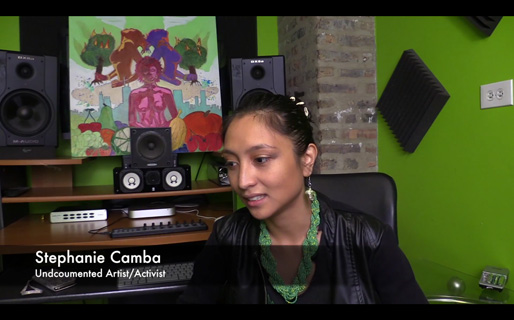
Born in Quezon City, Philippines, Stephanie Camba spent most of her childhood in the Marshall Islands. She said her family first moved to escape poverty, political persecution, and violence, but she eventually found herself immersed in the land and culture of her adopted home. After the attacks of September 11th, 2001 raised uncertainties about security and the economic future, however, Camba’s entire family made the difficult decision to relocate to the U.S. This is where she first faced the social and political barriers that came with being an undocumented immigrant in the United States.
Since then, Camba has solidified herself in community organizing and has used her art to create healing spaces grounded in wellness and creative self-expression as a tool for systemic social change. She has been involved in many forms of activism outside of her art. This included participating in a direct action in 2013 on Chicago’s Michigan Avenue that blocked the street during a presidential visit in order to call attention to the plight of undocumented communities under the Obama administration.
Though she longs to reconnect with her culture and childhood home, Camba said the Marshallese are facing an unprecedented crisis. A number of the Marshall Islands remain less than six feet above water. As a result, the people of the Marshall Islands are feeling the impacts of rising sea-levels, and the nation is a leading voice raising awareness of climate change through global forums such as the United Nations Framework Convention on Climate Change.
Global warming has triggered rising water levels in the South Pacific of about a foot over the past 30 years, faster than elsewhere–creating thousands of climate refugees. The climate crisis only adds to the environmental problems already faced by the Marshall Islands. From 1946-58, the United States tested atomic bombs there, setting off more than sixty nuclear explosions. Some islands, like Bikini Atoll, are still unlivable due to the high levels of radiation.
To this day, the Marshall Islands remain one of the United States’ most important military outposts in the Pacific. The arrangement between the U.S. and the Marshall Islands allows Marshallese nationals the right to live and work in the U.S. mainland freely. However, it leaves others who grew up there but do not possess Marshall Islands citizenship, like Camba, in a legal limbo. Even though she lived in the Marshall Islands for much of her childhood, she is not able to enjoy the U.S. immigration advantages given to the Marshallese. Additionally, returning back to the island of Majuro is becoming increasingly untenable, given the severity of oceanic water rise. Camba said she sees no choice other than to speak out on behalf of the climate refugees, many whom she considers family, that have been created through the political apathy surrounding environmental conservation.
Stephanie now resides in Chicago, where she continues to remain engaged in her community as the DACA and Community Outreach Coordinator at AFIRE (Alliance of Filipinos for Immigrant Rights and Empowerment). Through her art and her activism, Camba hopes to address the state-sponsored violence inflicted on undocumented individuals across the country, as well as the specific problems faced by climate refugees.
Photo: Earchiel Johnson/PW













Comments